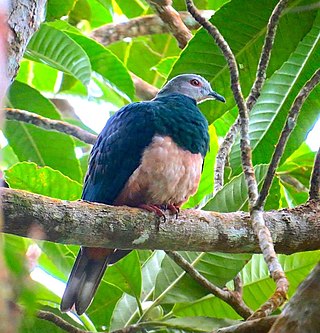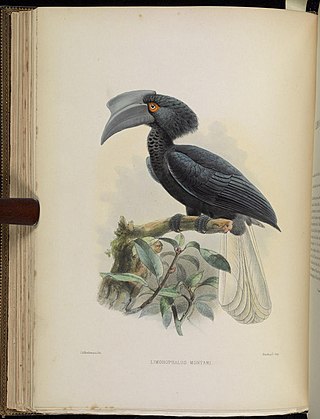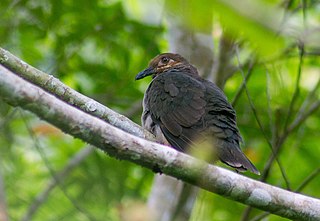
The pink-bellied imperial pigeon, also known as the zone-tailed pigeon, is found in the Philippines. It is a large fruit-eating bird reaching sizes of up to 42cm long.

The Sulu bleeding-heart or Tawitawi bleeding-heart is a species of bird in the pigeon and dove family, Columbidae. It is endemic to the island of Tawi-Tawi and its surrounding islets in the Philippines' Sulu Archipelago. This species is known only from two specimens collected in 1891, and has not been recorded with certainty since. It lives in primary and secondary forests that have a closed canopy. The Sulu bleeding-heart is a medium-sized pigeon with a short tail. Bright metallic green feathers stretch from the forehead and crown down to the mantle and sides of the breast, where they surround a large, pale orange breast spot with diffuse edges that gives the species the name "bleeding-heart". The lower wings and back are varying shades of brown, and the throat and chest are largely white. The belly is an ashy-gray.

The white-eared tailorbird is a species of bird formerly placed in the "Old World warbler" assemblage, it but now placed in the family Cisticolidae.It is found in the Philippine islands of Basilan and West Mindanao.

The Sulu hornbill, or Montano's hornbill, is a species of hornbill in the family Bucerotidae. It is endemic to the Sulu archipelago in the Philippines, with the remaining populations in Tawi-Tawi with it believed to be hunted to extinction on Jolo. Its natural habitat is tropical moist forests. It is threatened by habitat loss as well as potential harvesting for food. Its diet includes fruit, insects, and small lizards.

The blue-winged racket-tail or Sulu racquet-tail is a species of parrot in the family Psittaculidae. It is endemic to Tawi-Tawi island in the Philippines and is one of the most endangered parrots in the world. It is threatened by habitat loss and the poaching for the cage-bird trade.

The streak-breasted bulbul is a songbird species in the bulbul family, Pycnonotidae.

The amethyst brown dove is a species of bird in the family Columbidae.

Brown doves are members of the genus Phapitreron in the pigeon family. Their common name refers to their overall brown coloration. They are endemic to the Philippines. All brown doves are tree-dwellers, but the different species occupy different types of wooded habitats; some are more restricted to old-growth forest while other make use of secondary forest and other woodland. Their main diet is fruit. They tend to be solitary in their habits and can be elusive. Some species in this genus have conspicuous black and white stripes on their faces and iridescent neck feathers. Males and females look alike.
The Mindanao brown dove is a threatened species of bird in the family Columbidae. It is endemic to forests on the Philippine islands of Mindanao and Basilan, but it has not been recorded from the latter island since 1937. It is threatened by habitat loss and hunting. Until recently, it was considered conspecific with the Tawitawi brown dove and collectively called the dark-eared brown dove.

The Black shama is a species of bird in the family Muscicapidae. It is endemic to the island of Cebu, Philippines where it is known locally as "Siloy".

The black-bibbed cicadabird or black-bibbed cuckooshrike is a species of bird in the family Campephagidae. It is endemic to the Philippines. The species is elusive and poorly known.

The Sulu pygmy woodpecker, also known as the Sulu woodpecker, is a species of bird in the family Picidae. Formerly lumped with the Philippine pygmy woodpecker, it seems to form a superspecies with this and the Sulawesi pygmy woodpecker. Some taxonomic authorities continue to place this species in the genus Dendrocopos or Picoides.
The Mindanao boobook or Mindanao hawk-owl is a species of owl in the family Strigidae that is endemic to the Philippines on the island of Mindanao. It was previously known as a subspecies of the Philippine hawk-owl, but was reclassified in 2012, as voice and other evidence suggested it a distinct species. It is found in tropical moist lowland forest. It is threatened by habitat loss.
The Mindoro boobook or Mindoro hawk-owl is a species of owl in the family Strigidae that is endemic to the Philippines.
The Romblon boobook or Romblon hawk-owl, is a species of owl in the family Strigidae that is endemic to the Philippines. It is only found on the islands of Tablas, Sibuyan and Romblon. It was previously known as a subspecies of the Philippine hawk-owl, but was reclassified in 2012, as voice and other evidence suggested it was a distinct species. Its natural habitat is tropical moist lowland forest. It is threatened by habitat loss.
The Cebu boobook or Cebu hawk-owl is a species of owl in the family Strigidae. It is endemic to the Philippines. It was formerly considered a subspecies of the Philippine hawk-owl, but was reclassified in 2012, as voice and other data suggested placement in a distinct species.
The Sulu boobook or Sulu hawk-owl is a species of owl in the family Strigidae. It is endemic to the Sulu Archipelago in the Philippines. It was previously known as a subspecies of the Philippine hawk-owl, but was reclassified in 2012, as voice and other evidence suggested it was a distinct species. It is found in tropical moist lowland forest. It is threatened by habitat loss.
Dark-eared brown dove has been split into two species:

The grey-breasted brown dove is a subspecies of amethyst brown dove in the family Columbidae. It is endemic to the Philippines being found in Negros and Panay. Its natural habitats are or tropical moist lowland forests and tropical moist montane forests. It is found in lowlands but probably prefers middle and high elevations at 500-2000m. It is most often seen singly or in pairs, in and around fruiting trees. The call is a deep, sonorous "hoot-hoot-hoot-hoot", and birds may sit and call for long periods.












